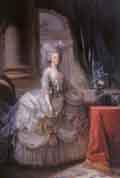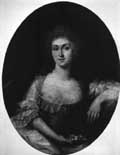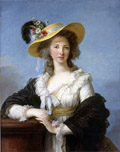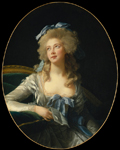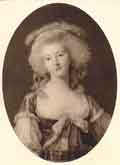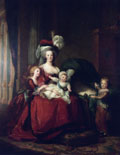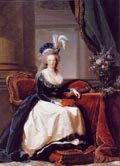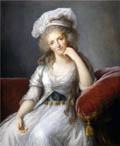|
Reprinted from ANTIQUES, November 1967, pp. 706-712
Vigèe-Le Brun And The Women Of The French Court
BY Ilse Bischoff
Vigée Le Brun's Home Page | Index to Art Pages
Vigée Le Brun's Gallery | Vigée Le Brun Biographies
Two IMAGES of Marie Antoinette are familiar to us: one of a radiant young woman at the height of her splendor, the other of a proud old hag, hands tied behind her back, seated in a tumbrel on the way to the guillotine. The latter comes from a stark line drawing sketched by Jacques Louis David (1748-1825) a few moments before her execution; the former from the beautifully painted portraits by Marie Louise Elisabeth Vigèe-Lebrun (1755-1842). Vigèe-Lebrun (she spelled it Le Brun) is known especially for her portraits of women and as the favorite portrait painter of Marie Antoinette and her court. Her twenty to thirty portraits of the Queen, though her most famous, form only a small part of her work. Of her 877 paintings, at least 662 were portraits. She reached the peak of her popularity between 1779 and 1789, just before the outbreak of the Revolution.
If there were many portents of coming political disaster, the exquisite women of French society, leading carefree lives with no thought but of pleasure, showed neither worry nor anxiety in their beautiful young faces as Vigèe-Lebrun painted them. The lines of character did not concern her, nor, for that matter, did they interest most other painters during the time of her supreme success in the 1780's. She herself was among the most beautiful French women of that time, and she was gifted and industrious too. She carved out a career of distinction and in her own field was as pre-eminent as Madame de StaÎl, whom she painted in 1808, was in hers. While she continued to paint elsewhere after the French Revolution, it is through her eyes that we see the gaiety and elegance of the French upper classes before the fall of the Bastille in 1789.
When Louise Elisabeth Vigèe was born in Paris, the Marquise de Pompadour (1721-1761) ruled at Versailles and the court, under Louis XV, was enjoying its period of greatest opulence. At the age of five Louise Elisabeth was taken from the peasants' house where she had been placed by her parents to the convent of La Trinitè behind the Bastille. What stood out in her later memory of those years was her constant preoccupation with drawing. As early as she could remember she defaced the margins of her copybooks with little heads and profiles; she covered the spotless walls of her dormitory with drawings and was roundly punished by the nuns. Once her father, Louis Vigèe, a painter but a minor one, saw her draw the head of a bearded man with the light of a lamp falling on his face, an ambitious subject of light and shade for a child. He exclaimed with delight, "You will be a painter if ever I saw one!"
Louise Elisabeth Vigèe's father died when she was thirteen and the burden of supporting her mother and younger brother fell on the girl. She was able to make her living by painting portraits and rapidly established a following. When her mother remarried, she found time to study the old masters in the collections open to the public -- among others. that of the Duc d'Orlèans and that in the Luxembourg Palace, where she saw the famous series of twenty-four allegorical scenes (now in the Louvre) by Peter Paul Rubens showing the life of Marie de Mèdicis. As she tells us in her memoirs, published in 1835, she was spell-bound by these first encounters with great paintings: until then she had seen only the work of her father and his friends. The influence of the Flemish painters always remained with her; the rich colors of Rubens' and Van Dyck's palettes, the effect of light on velvet and satin, were stored away in her subconscious. Except for nature, the advice of friends, and the works of the great masters, Louise Elisabeth Vigèe never had any teachers. Painting became her passion as well as her profession, and she trained herself with great earnestness, copying the portraits of Rubens, Van Dyck, and Rembrandt, studying the delicate half tones in the work of her friend and contemporary Jean Baptiste Greuze (1725-1805).
Under the prevailing system of corporations, Louise Elisabeth Vigèe was not allowed to earn money by painting unless she was registered as an apprentice or a master painter. Therefore, in 1774 she exhibited at the Salon of the Academy of St. Luke (the painters' guild to which her father had belonged) and was accepted for membership. From that date she became a fashionable portrait painter and began to receive commissions from the nobility. Her first order from the court was in 1776 from the Comte de Provence, the King's brother, who later became Louis XVIII.
While still in her teens Louise Elisabeth Vigèe attracted the attention of other successful painters, and by the time she was twenty she was known even to the august members of the Royal Academy of Painting (now the French Academy): having heard that the portraits of Andrè Cardinal de Fleury and Jean de La BruyËre were missing from the academy walls, she offered to paint them from engravings and then presented them to the academy in 1775.
It was primarily as a painter of women that Louise Elisabeth Vigèe gained her reputation, for when it became known that she not only caught an excellent likeness but rendered a flattering portrayal as well, women flocked to her studio. She made it a rule never to keep her models waiting; her palette and brushes were always ready. She put the convenience of her models before her own and usually did a head in three to four sittings, in order not to tire her subject. To put her models at ease she gave them something to lean against or a footstool for their feet. "Engage them in conversation." she advised in her memoirs, "flatter them, tell them they are beautiful, their complexions are marvelous, and they pose well. That puts them in a good humor."
In January 1776, when she was twenty, Louise Elisabeth Vigèe married the picture dealer Jean Baptiste Pierre Lebrun, who was also a painter. It was not a happy marriage, but he helped her more than anyone else, she admitted later in life, by criticizing her work and letting her study the great pictures which passed through his hands on their way to wealthy clients. A child, Julie, was born to the couple in 1782 and she appears in Vigèe-Lebrun's famous self-portrait (Fig. 1) in which she is shown at the age of seven in her mother's arms.
In 1779 when Vigèe-Lebrun was twenty-four, a portrait was commissioned which was to establish her career as a portraitist. She was called to Versailles to paint Marie Antoinette -- an extraordinary honor. She had done portraits of the Queen before this, at the request of various nobles, but never from life. On the day Vigèe-Lebrun was to start the Queen's portrait at Versailles she dressed as if for a fete and timidly mounted the stairs to the Queen's apartments. She was impressed by the Queen's grandeur and momentarily lost her self-confidence. Then, reassured and enchanted by Marie Antoinette's kind words and manner, she endeavored to paint what her eyes beheld, a regal and beautiful young woman. She and the Queen were exact contemporaries, and
a friendly relationship developed between them. Though the large portrait (Fig. 2) progressed rapidly, the artist felt she could not really capture the freshness, the delicate tints, the beauty of that face. And in fact that first, idealized portrait of the Queen in an enormous skirt paniers is the least successful of Vigèe-Lebrun's many paintings of Marie Antoinette. The fabric of the dress is accomplished; flowers, ribbons, tassels are charmingly rendered; but the hand holding a rose is boneless and carelessly drawn. Nevertheless, the picture was such a success that between the years 1779 and 1781 Vigèe-Lebrun was commissioned to paint six replicas, to be sent as gifts from the King. The original was intended for Marie Antoinette's mother, Empress Maria Theresa of Austria, but was ultimately given to the Queen's brother, Emperor Joseph II, and now hangs in the Kunsthistorisches Museum in Vienna. Two of the copies are in the French state collections. It is said that one copy went to the American Congress as an expression of Louis XVI's sympathy with the newly liberated colonies. Another, sent to Catherine the Great, was probably the first painting by Vigèe-Lebrun to reach Russia, where eventually she would spend six years.
Upon completion of this portrait the Queen's friends and court swarmed to Vigèe-Lebrun's studio. One of the first to come was the Princesse de Lamballe (Fig. 3), whose tragic death at the hands of the Revolutionaries took place in 1792. The Queen's current favorite, and governess to her children, the Duchesse de Polignac (Fig. 4), sat several times for Vigèe-Lebrun. She and her daughter, the Duchesse de Guiche, were among the handsomest women at a handsome court, as Vigèe-Lebrun's portraits testify. Among other beauties she painted were the Comtesse de Sabran; the Vicomtesse de Sègur, wife of the French ambassador to Russia; and Madame de Moley, owner of the charming property of Malmaison, later beloved of Empress Josephine.
Painting Marie Antoinette and her court fulfilled part of Vigèe-Lebrun's driving ambition to be one of the leading portrait painters in Paris. Protocol refused her, as a commoner, the right to mingle socially at Versailles. She could paint the Queen, sing songs with her while she worked; she could be part of the public allowed to watch royalty dine. But that was as far as etiquette permitted her to go. It could not have mattered much to her. She had her own salon made up of writers, artists, and musicians -- more interesting than the members of the court, who came to her salon to relieve the tedium of court life. Nevertheless, Vigèe-Lebrun valued very highly the royal patronage accorded her, and it was through the Queen's intervention in 1783 that she was granted the coveted membership in the prestigious Royal Academy of Painting.
In her portrait of Madame Grand (Fig. 5) (also spelled Grant), adventuress and mistress -- later wife -- of the Prince de Talleyrand-Pèrigord, Napoleon's future great minister and règisseur of the Congress of Vienna, Vigèe-Lebrun captured the youthful skin, the brilliant blond coloring, the quality of hair of which Madame Grand was proud. The notes on the sheet of music which Madame Grand holds, the silk dress, blue ribbons, lace, and the transparent mousseline, all painted with a feminine love of finery, are perfect examples of the artist's facility with costume and details. Once General Lafayette called to watch the progress of the portrait of the Comtesse de Simiane, (Fig. 6), whom Vigèe-Lebrun said he was "looking after."
When Marie Antoinette was indulging her whim for the simple life and enjoying her hameau at Versailles, she requested Vigèe-Lebrun to paint her as the country lass she affected to be. The artist much preferred painting the Queen in simple dress(Fig. 7) and portrayed her here in it muslin dress ("en gaulle") with a rose in her hand, wearing a large straw hat trimmed with ribbons and plumes -- not precisely a picture of a farmer's wife, but hardly a proper picture of a queen. The Comtesse de Provence was similarly painted, but without a hat, and Vigèe-Lebrun exhibited both portraits at the Salon of the Royal Academy of Painting of 1783. Their appearance created a scandal. A secret Polish memoir stated that the two princesses were wearing shifts and that the public was shocked to see such distinguished women dressed in clothes usually reserved for the intimacy of the palace. The ensuing uproar was so great that the paintings were hastily withdrawn. The Queen, however, was pleased by the portrait and gave almost identical copies of it to her friends: one to the Princess Louise de Hesse at Darmstadt and the other to Charles de Damas, Comte de Simiane, whose wife was painted several times by the artist in 1783 and 1789 (see Fig. 6).
Vigèe-Lebrun continued to portray the Queen, always with dignity and beauty, as if age could not touch her. But when she received the command to paint a large portrait of Marie Antoinette with her children (Fig. 8), the last portrait she did of her royal patron from life, she was confronted with the most difficult task of her career. The Queen would pose only for the head, and the children were not to be present while the composition was worked out. The artist used models and borrowed the necessary props and prepared her canvas in her studio, blocking in the figures and leaving room for the heads. For the finished painting of the Queen's face she took the picture to the Trianon. Antagonism against Marie Antoinette was reaching its height when Vigèe-Lebrun exhibited this painting at the Salon of the Royal Academy of Painting of 1787, but the critics were enthusiastic. The portrait is rightly called one of the great pictures at Versailles. The artist has succeeded in portraying the Queen as both regal and maternal. The different textures of red velvet and red satin are depicted with extraordinary skill.
All of Vigèe-Lebrun's devotion to Marie Antoinette and her sympathy for her are in the portrait painted in 1786 of which she made a replica (Fig. 9) in 1788. Here, even more than usual, she minimizes Marie Antoinette's less fortunate features -- the rather protuberant eyes and the Austrian nose. This portrait and the preceding one were painted from the same series of sittings.
In contrast to the somber dignity of these two royal portraits is Vigèe-Lebrun's joyous painting of the Marquise de Pezè and the Marquise de Rouget with her two children (Fig. 10). One of her finest group portraits, it is a luminous picture of two happy women with affectionate children, betraying no premonition of the dark days lying just ahead. Here Vigèe-Lebrun was at her height in rendering textures, from the glowing complexions to the changeable taffetas, striped silks, and the airy mousseline de sole of the headdresses. The small unobtrusive still life of roses at lower right is exquisitely painted; the landscape behind the balustrade gives a sense of distance and spaciousness.
One of the last portraits Vigèe-Lebrun painted before the Revolution was of the Duchesse d'Orlèans (Fig. 11). Her husband, a brother of Louis XVI, was known as Philippe Egalitè during the Revolution, and was bitterly criticized by George IV as a traitor to his class. He was executed in 1793.
After the fall of the Bastille in July of 1789, Vigèe-Lebrun began to fear for her life. She was too closely associated with the court to be safe in Paris. At midnight of October 6, the day on which Marie Antoinette and Louis XVI were brought by the mob from Versailles to Paris, Vigèe-Lebrun escaped with her seven-year-old daughter, Julie, and a governess by public coach from Paris to Lyons and over the Alps to Italy. She left Paris disguised as a working woman, terrified of being recognized, since her self-portrait (Fig. 1) had been exhibited at the Salon of the Royal Academy of Painting two months earlier. Her exile was to last twelve years and to take her throughout Italy, to Austria, to St. Petersburg for six years, and to England. Everywhere her reputation had preceded her and her portraits were much in demand.
It is as a painter of French women of the last few years of the ancien règime that Vigèe-Lebrun won her fame. In their portraits she achieved the finest expression of her talent. Pierre de Nolhac, late curator of Versailles, in his book Madame Vigèe-Lebrun: peintre de Marie Antoinette (Paris, 1908), gave her a tribute nearly seventy years after her death which she would have liked: 'This lovely Parisian who was in the service of frivolous queens and beautiful women of the court and theater does not belong among the great painters, but she has her place among the masters of portraiture, for she rendered an exact image of her epoch . . . She understood the women of her generation marvelously well and portrayed them as they dreamed of being admired'... In them we find our ancestors in straw hat or artfully careless fichu: those who gather field flowers. those who embrace their blond children, and who also suffered the miseries of exile, valiantly or went with a firm tread to the scaffold . . . It is the French woman whom Madame Vigèe-Lebrun knew how to paint best and it is through her that she will have lasting glory."
Vigée Le Brun's Home Page | Index to Art Pages
Vigée Le Brun's Gallery | Vigée Le Brun Biographies

|

